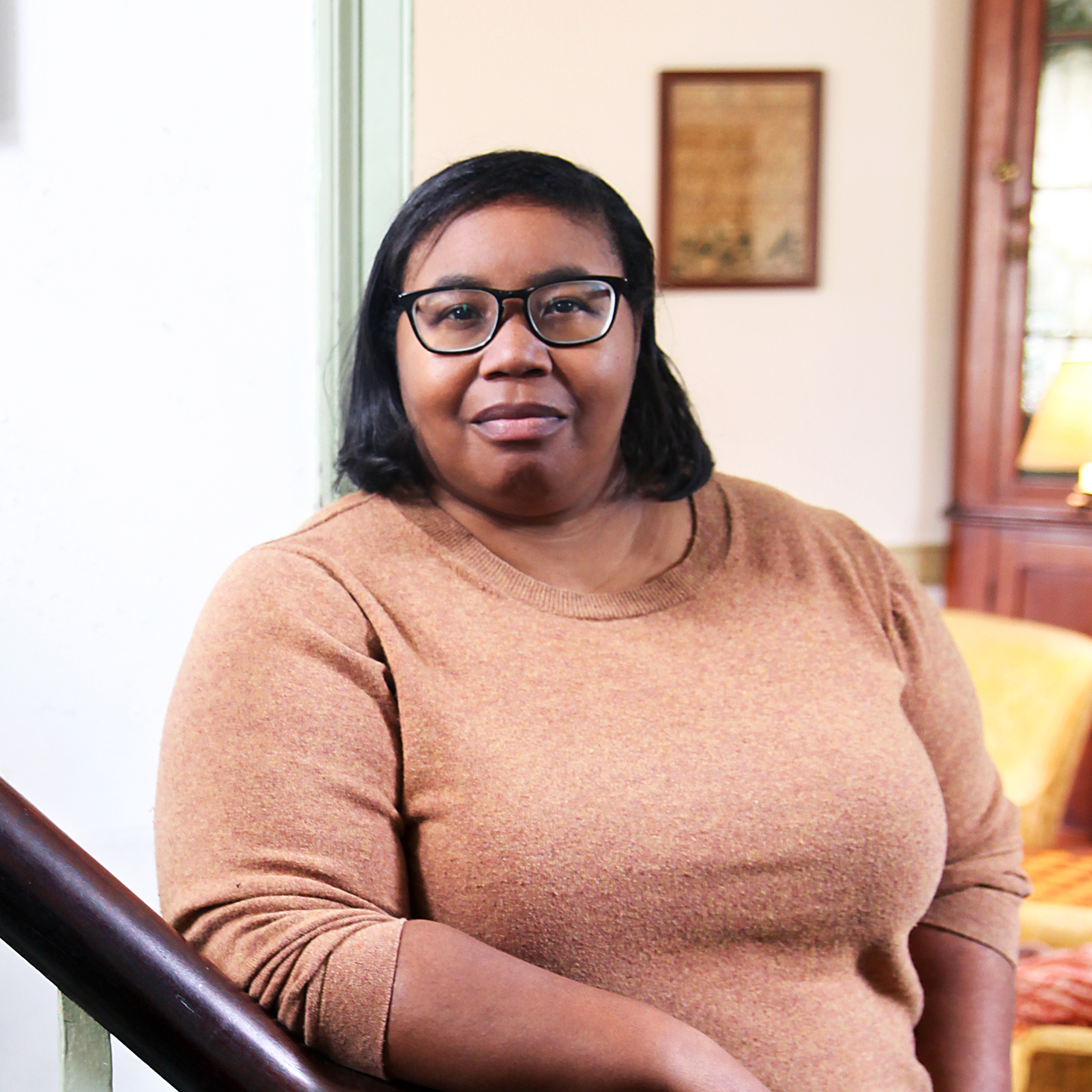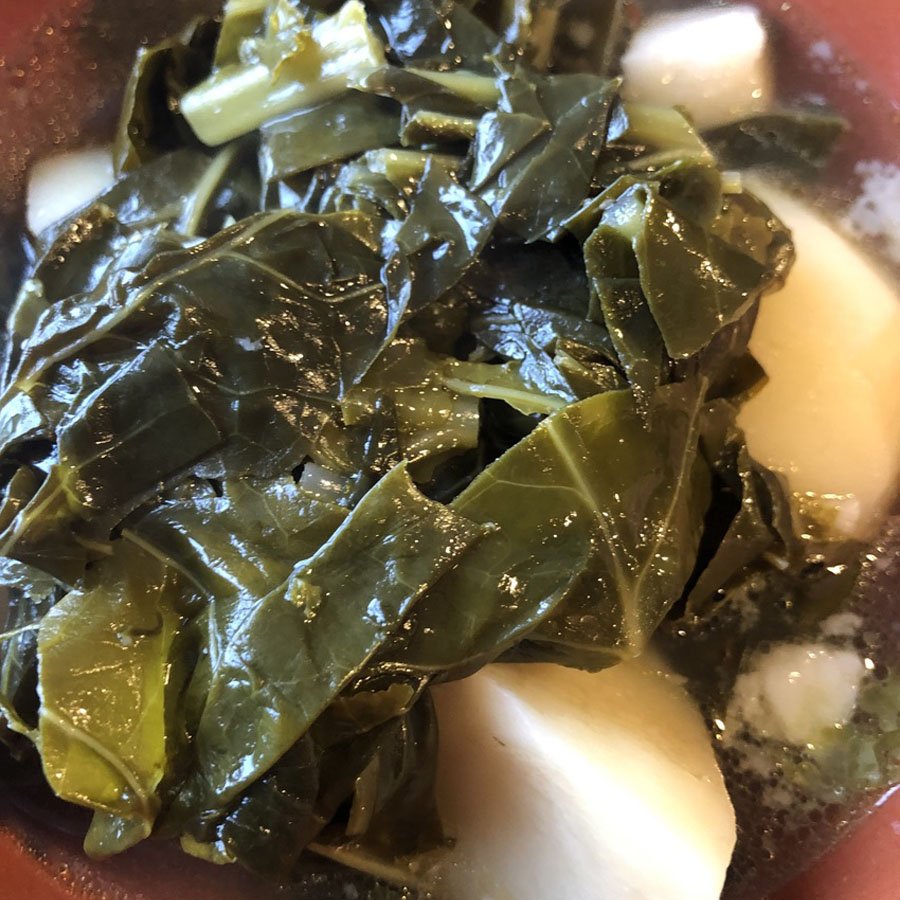Episode 2: Deb Freeman and Her Nana’s Collard Greens
New episodes and recipes every Friday!
“I’m looking for a connection to my ancestors through food” explains Deb Freeman, food writer, and host of the acclaimed podcast Setting The Table. She keeps an eye on Rajesh as he attempts to recreate her treasured nana’s collard greens - made with a twist. In return, Rajesh shares his mom’s bhindi bhaji: okra in a spicy tomato gravy.
In this episode, Deb Freeman talks about her work to reframe how we think of American food - because so much of it was created and perfected by enslaved people, from BBQ to fried chicken and, yes, collard greens: “There’s very little that African American hands have not touched when it comes to food in America.” It’s another reason Rajesh chose to share his mom’s okra recipe in this episode - it’s another vegetable first brought to American shores by enslaved people.
Find both recipes on this page.
Food is an expression of our shared humanity, and everyone has a food story to tell. What’s yours? Get in touch at rajesh@findingourflavor.com. And if you try any of these recipes, email and let us know how they turned out - if you send us a voice note, we might use it in a future episode!
Episode 2 Recipes
Deb Freeman’s Nana’s Collard Greens
This episode of Finding Our Flavor was the first time Deb Freeman shared this cherished heirloom recipe with anyone outside her family - and it’s the first time she’s had to write it down! Don’t worry if precise steps are in short supply - flavor is not! Just make sure you have time and patience. As Deb says in the show: “you can’t have anywhere to go if you’re making this dish.”
This is Deb’s recipe with a few additions by Rajesh to clarify a couple of steps. These quantities will yield a large amount. Rajesh halved the quantities - also because he didn’t have a big enough pot! - and there was still plenty.
Ingredients
5-6 large white potatoes
3 pounds collard greens (buy more because you will cut off and discard much of the stems)
Red pepper flakes (to taste)
1 lb fatback (easily available at most supermarket meat counters, but 1 lb of cut country style ribs will also work)
Apple cider vinegar (this is to taste, but start with ½ cup)
*(Note there are NO other seasonings required)
Instructions
Fill a large pot ¾ with water (Rajesh used 10 cups of water for half the quantity of ingredients).
Slice the fatback into one-inch strips, add to the water, bring to the boil, reduce and leave to simmer, covered, for about 90 minutes to two hours. (When the fatback has turned more translucent, it’s probably ok to add the other ingredients)
Rinse collards until there is no grit. Cut off the thickest parts of the stalks and discard (keeping some of the stalks).
Taking two or more leaves together, roll them up like tobacco leaves in a cigar, and slice so the biggest part of the leaves are like ribbons about half an inch wide. Chop whatever stalks you retained to a matching size. Add to the pot, using a wooden spoon to push them well down into the liquid.
Peel and cut the potatoes into four sections, and add them to the pot also.
Add the red pepper flakes and the apple cider vinegar.
Bring back to the boil, then reduce the heat, cover, and leave to simmer for around another 90 minutes to two hours, or until potatoes and greens are tender (a knife should easily pierce the potatoes but they should not disintegrate).
Whether you eat the pork fat is up to you, but when serving make sure to get some potato and some of the pot liquor along with the greens. Deb wholeheartedly approved when Rajesh suggested some fried chicken as an accompaniment!
Rajesh’s Mom’s Bhindi Bhaji
Ingredients
Around 10-11 ounces (300g) bhindi, chopped into 1-inch pieces (can also use frozen that has defrosted for a couple of hours).
1-inch - 1½ - 2 inches of ginger peeled, and finely chopped. (If the ginger has a wide diameter use the lesser amount; otherwise use more of the standard, thinner ginger)
1 green chili, deseeded, and chopped.
1 medium onion, peeled and finely chopped.
A little over 3 tablespoons vegetable oil.
Just under 3 tablespoons chopped tomatoes (about ⅓ of a can)
⅓ teaspoon turmeric
1½ tsp heaped coriander powder
Just under ¾ tsp salt.
Instructions
Heat the oil, then add onions and fry on a medium-high heat, turning regularly to stop them sticking. Once the first few pieces have started to brown a little, add ginger and chili, reduce the heat, stir and fry together until the spices release their fragrance but do not start browning. More of the onion will have taken some color by now, which is what you want. Scoop the tomatoes from the can, draining off the juice and adding the fleshy parts. Stir to cook. Add the dry spices, stir to combine, then reduce to simmer, cover, and leave to cook.
(If you’re using frozen bhindi, add them to the pot when the ginger and chili have released their fragrance – before the tomatoes. Check the heat is on medium, stir everything occasionally in order to evaporate off the water in the frozen bhindi. When you can see there is no remaining ice or frost and the bhindi look warmed through, then add your salt and dry spices. Fry for a few seconds and then add tomatoes).
The masala will start to release oil – it will look like there’s quite a lot but that’s ok: bhindi needs oil to cook.
Add the bhindi, turn and mix them into the masala. Add the salt and mix. The mixture will have a slightly sticky, almost slimy texture – don’t worry! This is the moisture from the bhindi coming out.
Cover and leave on just under medium heat to cook, checking regularly to stop the bhindi catching on the bottom. If it does, reduce the heat, cover and leave to cook for at least 5 minutes before checking again. Then leave it again. As with all my mom’s recipes, the important thing is not to be impatient: let it cook!
After 5-7 minutes, check again and taste. Adjust salt if needed.
The bhindi should be soft but retain their shape and texture. That’s when you know it’s cooked.









